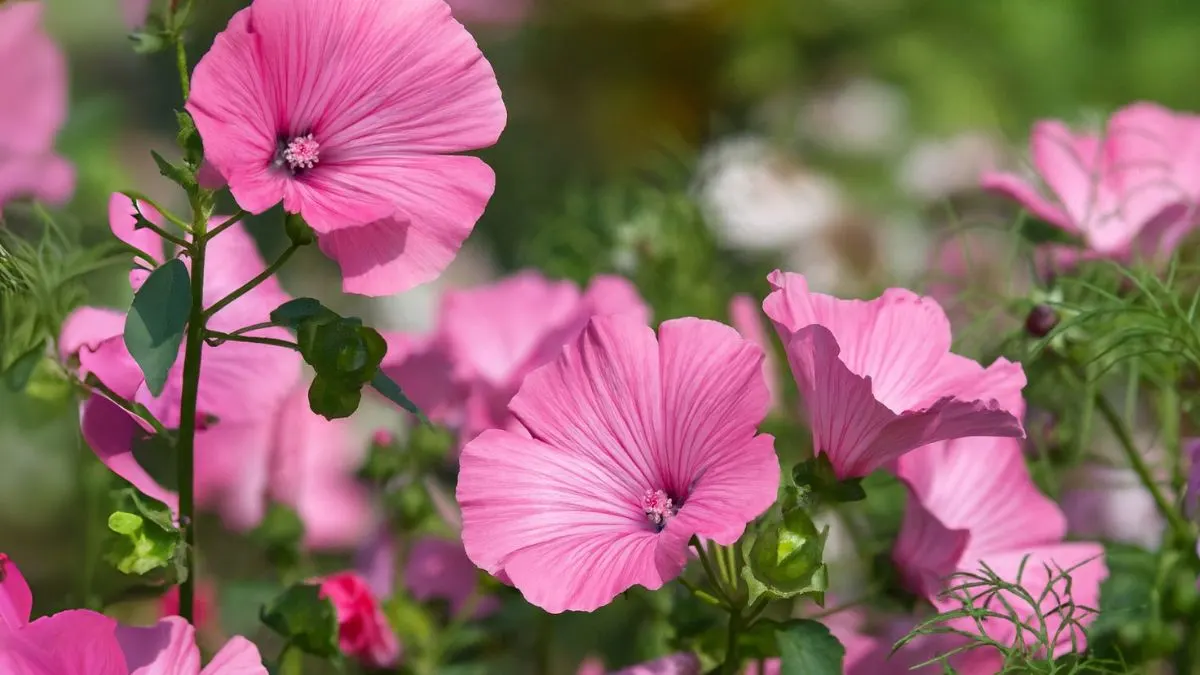When you think of versatile plants, few can match the charm and resilience of the mallows flowers. Belonging to the Malvaceae family, these blooms are celebrated not just for their ornamental appeal but also for their deep cultural and medicinal significance.
From the prairie mallow that brightens wild prairies to delicate hybrids in home gardens, mallows are plants that go beyond simple decoration. They are easily cultivated, hybridize readily, and adapt to a wide range of environments. But what makes them truly special is that the plant is traditionally used to cure many ailments, giving it both beauty and purpose.
The Allure of Mallow Flowers

Showy Blooms for Every Garden
One of the most celebrated features of mallows is their flowers. Mallow flowers are known for their beautiful, showy blooms, which often resemble hibiscus in structure. They come in a range of colors—soft pinks, purples, and whites—that add vibrancy to both wild meadows and manicured gardens.
The best part? These blooms attract pollinators like bees and butterflies, making them not just ornamental but also ecologically valuable. In my own backyard, planting a row of pink mallows turned into a summer spectacle, buzzing with life every morning.
Prairie Mallow: A Native Star
The prairie mallow is one of the most resilient species, native to North America. Known for its hardiness, it can tolerate diverse conditions, from prairies to gardens, making it a favorite among gardeners who want low-maintenance plants.
- Height: 2–4 feet tall
- Bloom time: Mid to late summer
- Soil preference: Well-drained but adaptable
It’s especially popular in Canada and the U.S., where native planting is celebrated as an eco-friendly gardening choice. Beyond its beauty, it supports pollinator ecosystems, ensuring biodiversity thrives.
Also Read: Homalomena: The Plant That Looks Like a Heart and Acts Like a Hero
Easy to Grow and Hybridize
One of the best aspects of mallows is how easily cultivated they are. They don’t require high maintenance, making them perfect for beginners. Moreover, they hybridize readily, meaning new colors, flower sizes, and varieties are always appearing.
This adaptability ensures that gardeners worldwide can experiment with creating unique hybrids while still enjoying the reliability of strong, established species.
Feature |
Why It Matters |
Easily cultivated |
Perfect for beginner gardeners |
Hybridize readily |
Allows for diverse varieties in gardens |
Showy flowers |
Adds beauty while attracting pollinators |
Medicinal and Cultural Importance
Beyond their ornamental use, mallows have been used in traditional remedies for centuries. The plant is traditionally used to cure many ailments, ranging from respiratory issues to digestive discomfort. Roots and leaves have soothing properties, often used in teas and poultices.
Some traditional uses include:
- Relief from coughs and throat irritation
- Healing wounds and skin inflammations
- Easing digestive problems
In fact, ancient civilizations relied on mallows as one of their go-to herbal remedies. Even today, herbalists recognize its calming effects on the body.
Mallows in Modern Gardening
Gardeners in North America and Europe often see mallows as versatile additions to both ornamental and functional spaces. They look equally stunning in cottage gardens, prairie landscapes, and modern yards. Personally, I’ve found mallows to be forgiving plants—perfect for those of us who occasionally forget to water! Their resilience and long bloom season make them rewarding to grow, even in beginner gardens.
Also Read: Brazilian Lucky Wood: The Tree That Brings Fortune, Style, and Oxygen Indoors
Companion Planting
Mallows work beautifully with ornamental grasses, echinacea, and lavender, creating both visual and ecological harmony. Their deep roots help stabilize soil, while their blooms keep pollinators busy.
Tips for Growing Mallows
- Soil: While adaptable, they thrive best in well-drained soil.
- Sunlight: Full sun ensures more vibrant blooms, but some species tolerate partial shade.
- Watering: Once established, mallows are drought-tolerant but appreciate occasional watering during dry spells.
- Pruning: Cutting back after flowering can encourage new blooms and keep the plant tidy.
These tips make mallows one of the easiest additions to any garden, whether you’re in Canada, the U.S., or beyond.
Mallows are more than ornamental—they are history-rich, eco-friendly, and medicinally valuable. From the prairie mallow to endless hybrids that are easily cultivated, hybridize readily, these plants prove their worth in every corner of the gardening world. With mallow flowers known for their beautiful, showy blooms and the fact that the plant is traditionally used to cure many ailments, they embody the perfect blend of beauty and utility.
So, if you’re searching for a plant that offers more than just decoration, mallows might be the answer. Why not add them to your garden this season and experience the magic yourself?






